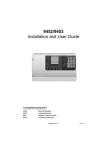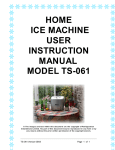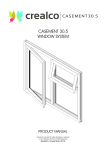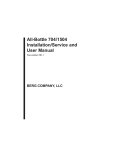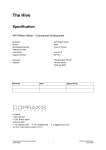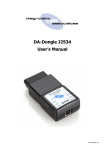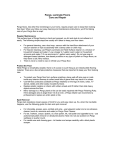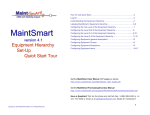Download User Manual - Crowstone Mail Order
Transcript
HOME ICE MACHINE USER INSTRUCTION MANUAL MODEL TS-0612B and MODEL TS-0612S © The images and text within this document are the copyright of Refrigeration Installations Limited. No part of this document may be reproduced in any form or by a n y m e a n s w i thout the prior written permission of the copyright owners. TS-0612 Version 05/05 o Page 1 of 1 Introduction This instruction manual covers the operation of the Home Ice Machine models TS-0612B and TS-0612S. Both models provide the same functionality, the difference being cosmetic. Model TS-0612B has a brushed/stainless steel finish and model TS0612S has a shiny/bright chrome finish. Please read these instructions carefully and retain them for reference. The appliance must be connected to a (nominally) 240V AC 50Hz. earthed electrical supply and be protected with a 13 Ampere fuse. The Home Ice Machine produces 12 ice cubes with each cycle of approximately 12 to 18 minutes, depending on the size of cube selected. The appliance is equipped with a Function Display panel that includes SELECT buttons for ice cube size selection (S for small, M for medium and L for large), START and STOP buttons and a WATERTANK condition monitor which gives a visual warning when the appliance is running low on water. The unit has a mains electricity ON/OFF switch on the back panel. It is recommended that the appliance is operated with small (S) cube size whenever conditions allow. TS-0612 Version 05/05 o Page 2 of 2 Parts Overview E D A B C A C E Ice Cube Drawer Water Level Indicator Cover/Window B D Water Tank Function Display Note: The On/Off Switch (not shown) is on the rear of the appliance. Detail of Function Display: TS-0612 Version 05/05 o Page 3 of 3 Preparing the Appliance for Use Unpack the appliance and place it on a sturdy level surface. It is recommended that the packaging be retained for secure movement or transport. The appliance operates at its optimum performance in a normal room temperature of 20 oC. The refrigerant inside the appliance must have time to settle following transportation and a minimum stabilisation period of three hours is recommended prior to switching on the appliance. There are two ventilation grilles in the appliance cover, one in the lower left hand side panel and one in the upper rear panel. To ensure correct appliance operation these grilles must not be obstructed. A gap of at least 10 cm. (4 inches) must be maintained between the appliance sides, rear and top and other appliances or walls. Remove the Water Tank (the lower of the two removable drawers on the appliance front face) and pour fresh drinkable mains tap water into the tank through the larger rectangular hole in the Water Tank lid and fill the tank up to the MAX line of the Water Level Indicator situated in the front centre of the tank. Commercially bottled still drinking water may be used if desired. Replace the Water Tank fully home into its recess. Ensure that the Ice Cube Drawer, the upper of the two drawers, is pushed fully home in its recess. Ensure that the clear Cover/Window on the top of the appliance is closed as the freezing element gets very cold during operation. TS-0612 Version 05/05 o Page 4 of 4 Appliance Operation Connect the appliance lead to the 3 pin socket in the rear of the appliance and plug the appliance into a suitable supply and switch on the ON/OFF switch situated on the rear of the appliance. The ON/OFF switch is illuminated and will light up. The appliance should be positioned for easy access to the ON/OFF switch and mains plug to facilitate rapid switch off and appliance isolation when required. The appliance may bleep several times whilst internal components that may have moved during transportation reset themselves. If this does happen the bleeping should last no longer than 20 seconds. If bleeping continues for a longer period pull the Water Tank and the Ice Cube Drawer out slightly and re-insert them ensuring that they are fully home in their recesses. When the Water Tank is withdrawn the WATER TANK indicator on the Function Display should change colour from green to red or red/orange, and when re-inserted it should go back to green. If the indicator stays red or red/orange this could indicate that the appliance internal water level detector is not operating correctly. Remove the Water Tank and check that the black float inside the transparent water level indicator on the right hand side of the rear of the Water Tank is free. If the float is stuck gently tap the indicator to free the float and the re-insert the Water Tank fully into its recess. Ice cube size S (small) of the SELECT display should be illuminated red as this is the default setting. If it isn’t depress the S button to illuminate it. Press the START button on the Function Display and keep it pressed for a couple of seconds. The appliance will start with the water pump, cooling fan and compressor starting to operate. Looking through the right hand side of the clear Window in the top of the appliance water will be seen entering the water tray. After approximately 12 minutes ice cubes will be deposited in the Ice Cube Drawer and the appliance will bleep four times. Do not attempt to remove ice cubes until after the four bleeps have finished otherwise the appliance will bleep continuously and the cubes may be deposited into the Ice Drawer recess rather than the Ice Drawer itself. If the appliance does bleep continuously ensure the Ice Cube Drawer is fully in its recess. The appliance will continue to produce ice cubes at approximately 12 minute intervals. Some variation in ice cube size should be expected on initial switch on however variation should be minimised once the appliance has stabilised. Other variables such as water temperature and ambient operating temperature can affect ice cube size. When the Ice Cube Drawer is full the appliance will detect this and bleep 10 times. The S, M and L lights will flash for 5 minutes and, if the Ice Cube Drawer is not emptied, the appliance will go into sleep mode. Emptying the Ice Cube Drawer and replacing it into its recess will re-start the ice cube making process. . TS-0612 Version 05/05 o Page 5 of 5 Appliance Operation (Continued) If the Ice Cube Drawer is not emptied the cubes will melt and the water produced will drain back into the Water Tank through the Ice Cube Drawer drain valve/hole. When sufficient cubes have melted the ice cube making process will re-start automatically. As water is drawn from the Water Tank the level will drop and eventually the WATER TANK indicator on the Function Display will turn from green to red, indicating that the tank requires topping up. It is not necessary to top up the tank immediately. The ideal time to top up the tank is a couple of minutes after water has stopped being pumped into the water tray. The reason for this is that towards the end of the cube production cycle the water tray inverts and any unfrozen water in the tray drains back into the Water Tank. If the Water Tank is removed for the purposes of topping up during this period then water will be deposited into the base of the appliance and then leak onto the surface on which the appliance is standing. Care is needed when topping up an appliance that has operated for more than one cycle. The water top up level should be to approximately 5 mm (¼ inch) below the MAX line of the Water Level Indicator situated in the front centre of the Water Tank. This is to allow the Water Tank to accommodate the contents of the water tray when it inverts without the Water Tank overflowing. The appliance can be stopped at any time by pressing the STOP button on the Function Display. If this is done the START indicator will flash. After Use When the appliance is not to be used for some time, for example for periods exceeding 48 hours, it is recommended that it be disconnected from the electrical supply and any remaining ice cubes and water be removed. Excess water in the Ice Cube Drawer, the Water Tank and water tray should be removed using kitchen towels or similar absorbent material. It is also recommended that the appliance is cleaned on a regular basis, perhaps once every three months or more frequently in areas where chalky deposits can be a problem. Two cleaning solutions may be used. One is 1 part vinegar to 10 parts water, the other is 1 part bicarbonate of soda to 5 parts water. In both cases the appliance should be allowed to complete one ice making cycle, then left to stand for 6 hours before being thoroughly rinsed with fresh water and dried as detailed in the previous paragraph. Solvents, detergents and abrasives must not be used for cleaning. The appliance exterior can be cleaned with a damp cloth and then polished with a soft, dry lint free cloth. TS-0612 Version 05/05 o Page 6 of 6 Hints and Tips Do not place the appliance on its side or upside down. Pay particular attention to this when the appliance is being moved or transported. Ventilation grilles must not be obstructed. Do not immerse the appliance in water or other liquids. The appliance has internal moving parts. Do not open the Cover/Window whilst it is connected to the electricity supply and take particular care to prevent children from getting access to or playing with the appliance. The ice making element gets very cold and touching them could result in ice burns. o Do not use water below 8 C for filling as this may cause the ice cubes to fuse into one large block of ice, particularly if medium (M) or large (L) ice cube size is selected. Always try small (S) ice cube selection first as this may give cubes of sufficient size. As with all electrical appliances if used outdoors ensure that it is protected from the elements and use an earth leakage contact breaker for safety. Do not expose the appliance to rain and do not use or store it where it could get damp or wet. Do not put the appliance near sources of heat. In case of damage to the appliance we advise not using it and returning it for authorised repair. Damaged leads are dangerous and must be replaced. Using parts not recommended by the manufacturer can be dangerous. Only use the appliance for its intended purpose, the production of ice cubes. Flavoured waters, fruit juice, cordials and similar products must not be used. The refrigerant gas used in the appliance (R134a) is chemical waste. Disposal of the appliance must be done in an environmentally friendly way. See Page 10 for further information on appliance disposal. TS-0612 Version 05/05 o Page 7 of 7 Problems and Malfunctions If the indicator light on WATERTANK is illuminated red the water tank level is low and requires topping up. If the L and START indicator lights flash and the appliance bleeps then the Ice Cube Drawer is not positioned correctly and should be removed and replaced firmly into its recess. There are a number of sensors associated with the Ice Cube Drawer and the Water Tank and faulty positioning of these units is the most common cause of malfunction. Always ensure that the Ice Cube Drawer and the Water Tank are correctly positioned in their recesses. If the M indicator is illuminated and the appliance bleeps, or the M indicator is flashing and the appliance is not bleeping, the ice cube production process is stuck. It may be that ice cubes are stuck to the freezing element, an ice cube is stuck in the mechanism or the ice cubes have fused into one large block of ice. If this happens switch off the appliance, unplug it from the mains electricity, open the Window and leave until all ice blockages melt. Once everything has melted close the Window, plug the appliance in to the supply, switch it on and depress START. In the event of any appliance stoppages, malfunctions or indicator light sequences not covered in these instructions switch the appliance off for one minute and then switch it on again. This should clear any spurious faults. For faults which cannot be cleared and for further assistance and service the contact information is shown on the next page. TS-0612 Version 05/05 o Page 8 of 8 Appliance Technical Data Voltage and Frequency: Maximum Power: Water Tank Capacity: Ice Cube Cycle Time: Dimensions (mm): Net weight: Approvals: Nominally 240V AC 50Hz 200W 4.5 litres approximately S (Small) M (Medium) L (Large) 360 x 390 x 440 19.5Kg. T h e n u m b e r o f i c e c u b e s p r o d u c e d p e r c y c l e i s 1 2 . T h e I c e C u b e D r awer holds approximately 60 cubes or 1 Kg. of ice. The appliance produces between 16 and 20 Kg. of ice in a 24 hour period dependent on water temperature and ambient conditions. Advice and Service The appliance is manufactured in China and Refrigeration Installations Limited is the United Kingdom Main Agent and Distributor. For advice or help on any matter please contact S y d L l o y d at:- Refrigeration Installations Limited Unit D9 Newton Business Park Cartwright Street Hyde Cheshire SK14 4EH Tel: 0161 366 1110 Fax: 0161 366 1190 Email: [email protected] TS-0612 Version 05/05 o Page 9 of 9 IMPORTANT ENVIRONMENTAL INFORMATION FOR PURCHASERS/USERS WITHIN THE EUROPEAN ECONOMIC AREA The European Parliament will enforce new regulations in 2006 concerning the disposal of electrical and electronic equipment such as the Home Ice Machine. The regulations, called Directives, place responsibilities on the appliance supplier and you, the purchaser/user. One of the actions required of suppliers is to inform users of their obligations. The appliance has been assessed in accordance with the European Parliament Directive 2002/96/EC on Waste Electrical and Electronic Equipment, usually referred to as the WEEE Directive. The WEEE Directive requires that the appliance is disposed of at the end of its useful life in an environmentally responsible manner. Similar requirements have applied to refrigerators for some time. Parts and materials that can be re-used and/or re-cycled have been identified in order that the use of new resources and the amount of waste going for landfill can be minimised. The WEEE Directive requires that if you are replacing the appliance with a new equivalent product from the original supplier then that supplier can collect the old item without cost to yourself. It is emphasised that this no-cost return option is only available when you purchase a new product of equivalent type that fulfils the same function. Please inform your supplier of your wish to have the old appliance collected when ordering the replacement. If you wish to dispose of the appliance without replacing it then the appliance must not be mixed with unsorted municipal waste. The crossed-out wheeled bin symbol on the unit label or unit packaging, and repeated below, indicates this requirement. You must ensure that the appliance is disposed of at an authorised treatment facility, details can be obtained from your local council. Your rôle is critical and will help to ensure that the Earth’s resources are maintained and that as much re-usable and re-cyclable material as possible is processed. It will also ensure that landfill volume requirements are kept at a minimum and that hazardous materials are not buried thereby providing potential future problems for the environment and human health. The WEEE Directive comes into force in January 2006. TS-0612 Version 05/05 o Page 10 of 10










